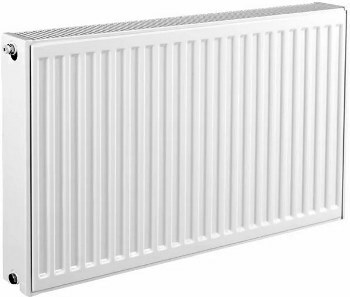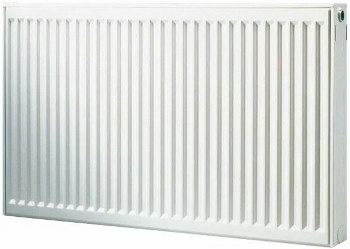The question of purchasing a radiator arises not only when building a house. It happens that it is cold in an apartment purchased on the secondary housing market, and you have to choose a new radiator. And the radiators themselves are reliable, but not eternal, so occasionally they still have to be changed. Which one to choose? Cast iron, bimetallic, aluminum? One of the more popular options is steel radiators. Why are they good, how to choose them and which 7 steel radiators were worthy of our independent Top 7, read on.
CONTENT
- 1 Advantages and Disadvantages of Steel Radiators
- 2 Types of steel radiators
- 3 What parameters should be considered when buying?
- 4 Connection types
- 5 Installation options
- 6 Top 7 steel radiators
- 7 FAQ
Advantages and Disadvantages of Steel Radiators
Steel radiators are attractive:
- affordable price;
- ease of installation;
- relative ease.
Their main disadvantage is their susceptibility to corrosion. To increase the service life of steel heating structures, they are coated with special paints. Self-respecting manufacturers use safe formulations that, even at high temperatures, do not emit substances hazardous to health.
In some cases, the panel and pipes can be painted in the color chosen by the buyer. Such a radiator will be in harmony with the color of the walls and the design of the room.
Types of steel radiators
By configuration, the products are divided into:
- tubular;
- panel.
Panel have the form of rectangular panels with channels through which the coolant circulates. The first samples of panel radiators appeared in our country in the 70s of the XX century as an alternative to the cast iron structures used everywhere. Unfortunately, the batteries, new for those times, did not show sufficient efficiency and could not squeeze out their cast iron counterparts.
Over time, the flaws were taken into account and panel radiators regained their place in the market. Modern designs are classified into the following types:
- type 10 - has only one row of panels without cladding and convector;
- type 11 - equipped with one convector and one panel (there is no grill in the upper part);
- type 20 - two rows of panels without a convector;
- type 21 - two panels with convection ribs;
- type 22 - two-panel radiator with two convectors;
- type 30 - three-row radiator without convectors;
- type 33 - three panels are combined with three convectors.
The configuration largely determines the efficiency and economy of the installation. For example, radiators of types 10 and 11 provide only direct air heating. During a severe cold snap, they need more time to bring the room temperature to optimal. Samples with convectors are considered more economical and efficient.
Tubular steel radiators were invented by the Swede Robert Zender in 1930. By the way, the products of the Zehnder company still occupy a leading position in the heating systems market.
This type of structure is a reliably welded pipe-like element. The absence of joints and gaskets ensures maximum durability. The risk of leaks is minimized.
The larger the number of pipes and the greater their height, the more solid the amount of heat given off.
What parameters should be considered when buying?
To choose the best steel radiators for a private house or apartment, you need to take into account the technical characteristics. One of the most important is heat transfer. It shows how much heat the structure gives off to the surrounding space per unit of time. The unit of measurement is Watts or kcal / hour.
In steel products, heat transfer is relatively low, but this drawback is compensated for by well-thought-out structural elements. For example, heating efficiency increases with the number of panels and with the addition of convectors. It should be borne in mind: the characteristics of the product may indicate the heat transfer of one section or the entire radiator.
When calculating thermal efficiency, you need to pay attention to the height of the ceilings, the number of external walls, and the climatic zone.
So, for example, for a room with ceilings up to three meters, with one window and one wall facing the street, 1 kW per 10 m2 of area is enough. For northern regions - 1.4-1.6 kW, for southern regions with mild winters - 0.8-0.9 kW.
You can use a special calculator for a more accurate calculation. Some manufacturers immediately indicate which area the radiator is intended for heating.
When choosing the best steel radiator for your home, other characteristics are also important, for example:
- coolant volume;
- operating pressure;
- maximum pressure test;
- maximum operating temperature.
To avoid problems with installation, you should take into account the dimensions of the radiator, its center-to-center distance, and the diameter of the connection holes in advance.
Connection types
There are several options for connecting radiators to the system.
- Side - eyeliner and layering are carried out from one side. This method is convenient in small rooms. It is not suitable for installing radiators from a significant number of sections, since the heated liquid will slowly reach the distant sections of the structure.
- Lower - convenient for hidden pipe routing.
- Diagonal - ensures uniform distribution of the coolant over all elements of the radiator.
Installation options
The most common way to install a radiator is wall-mounted. Such samples are used in apartments, private houses.
There are also floor-standing radiators - a practical option for rooms with stained-glass windows.
Built-in radiators are mounted in a niche. The outer part of the heating structure is flush with the surrounding surface. This arrangement makes the radiator almost invisible.
Top 7 steel radiators
For those who want to purchase a reliable steel radiator, the following models can be recommended.
Best Steel Tubular Radiators
1. Zehnder Charleston 3057 566 with bottom eyeliner

The Charleston 3057 566 radiator from the Swiss company Zehnder can be classified as expensive. Its purchase will cost more than 26 thousand rubles. The connection for this model is bottom, with a center-to-center distance of 50 mm, the placement is wall-mounted. The ends of the sections have a safety rounded shape. High quality powder paint is applied to the surface. Each section has three tubes that hold 1 liter of coolant. The number of sections can vary from 8 to 30. The maximum operating temperature of the coolant can be 110 degrees, the operating pressure is 10, and the pressure test is 15 atmospheres.
Price: ₽ 26 000
Zehnder Charleston 3057 566
2. Steel radiator Irsap Tesi2 565 with side connection

Irsap Tesi2 565 is a tubular version of a steel radiator with side connection (the center distance is 500 mm). The product is intended for wall mounting. The maximum operating temperature in the system should not exceed 95 degrees, and the operating pressure should not exceed 10 atmospheres, so it is undesirable to install it in houses with centralized heating. But in a private house with an individual heating system, this radiator will look great. The battery costs quite reasonable 10,000 rubles.
Price: ₽ 10 000
Irsap Tesi2 565
Best steel panel radiator with bottom connection
3. Kermi FTV (FKV) 12 500 1000

For a steel panel radiator Kermi FTV (FKV) 12,500,000 they ask about 6,700 rubles. Its maximum heat dissipation is 1427 W, so such a radiator will cope with heating a room with an area of no more than 15 square meters. The battery has a bottom connection and is designed for wall mounting. Like most Kermi radiators, this product is designed for an operating pressure of up to 10 bar and pressure testing up to 13 bar at a temperature not exceeding 110 degrees. The kit includes a set for self-assembly.
Price: ₽ 6 400
Kermi FTV (FKV) 12 500 1000
Best steel panel radiators with side connection
4. Kermi FKO 33 300 1000

Kermi FKO 33 300 1000, costing about 7 500 rubles, with very modest dimensions, has a solid heat transfer - up to 1837 W. This is enough to heat a room up to 18 square meters. The radiator is capable of withstanding a maximum operating temperature of up to 110 degrees, a maximum operating pressure of up to 10 atmospheres and a pressure of up to 13 atmospheres, so it is best to place this model in houses with an individual heating. The wall structure has a side connection, which is convenient for installation in an apartment.
Price: ₽ 7 500
Kermi FKO 33 300 1000
5. Axis Classic 22 300 1000

Axis Classic 22 300 1000 is a more efficient radiator for its low price. For 3,500 rubles, we are offered a wall panel device with a maximum thermal power of 1471 W, capable of heating a room of 14-15 square meters. The device consists of two panels and is designed for lateral connection with a center distance of 246 mm and a connection diameter of ½ ”. The maximum operating temperature is 120 degrees, the maximum operating pressure is 10 atmospheres, and the pressure test is 13 atmospheres.
Price: ₽ 3 499
Axis Classic 22 300 1000
6. Buderus Logatrend K-Profil 21 500 800

Buderus Logatrend K-Profil 21,500,800 worth about 4,500 rubles has a heat output of 1098 W - such a battery is enough to heat a room with an area of more than 10 square meters. This panel radiator is placed on the wall. The device is designed for lateral connection with a center distance of 450 mm. Connection diameter - ½ inch. The product is capable of withstanding a maximum operating temperature of 120 degrees and an operating pressure of 10 atmospheres, so its durability, when placed in a house with central heating, remains under a large a question. But in a private house, the radiator will serve you faithfully for many years.
Price: ₽ 4 451
Buderus Logatrend K-Profil 21 500 800
7. Purmo Compact 11 500 900

The price of Purmo Compact 11,500,900 does not exceed 3,000 rubles. At the same time, the operating power of this radiator is 781 W, and the maximum is 1193 W, so that it is able to warm up a room with an area of up to 10-11 square meters. The maximum fluid temperature in the system should not exceed 110 degrees. This design will withstand an operating pressure of 10 bar (pressure test - 13 bar). The product is placed on the wall, with a side connection (connection diameter - ½ ", center-to-center distance - 450 mm). A good budget option for a home with individual heating.
Price: ₽ 3 000
Purmo Compact 11 500 900
FAQ
Where is the best use of steel radiators - at home or in an apartment?
The best steel radiators can be used both in city apartments with central heating and in private houses. The main thing is to carefully think over the heating system scheme and calculate the optimal power of the batteries. And do not forget about high-quality antifreeze if the country house is rarely visited during the cold season.



